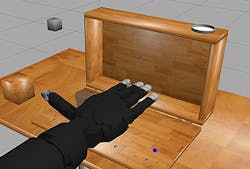DEKA Research to develop touch-sensitive robotic artificial limbs for injured warfighters
Officials of the Defense Advanced Research Projects Agency (DARPA) in Arlington, Va., announced a $7 million contract last week to DEKA Research and Development Corp. in Manchester, N.H., for the Hand Proprioception & Touch Interfaces (HAPTIX) program.
HAPTIX seeks to develop touch-sensitive prosthetic arms and legs for warfighters who lose limbs in battle. The project seeks to link artificial limbs with implantable devices for touch and muscle memory.
DARPA is asking DEKA engineers to design and build sensorized prosthetic arms for the HAPTIX program, as well as for the DARPA Revolutionizing Prosthetics Follow-on Studies (RPFS) project.
DEKA will train DARPA HAPTIX and RPFS performers on the setup and operation of the arm systems, provide technical support, and maintenance and repair of the arm systems during the HAPTIX program and RPFS studies.
Related: Prosthetics meet robotics
System performance and the ultimate benefit to prosthetic users will be determined in a yearlong, take-home trial. These efforts will position the government with the required data to seek market approval and deliver the system into the wider patient population.
The RPFS effort will provide the U.S. Food and Drug Administration (FDA) an approved variant of the DEKA arm system to researchers to inform product and reimbursement code submissions to the Center for Medicaid and Medicare Services.
These studies also will validate prescription criteria and explore other control techniques with the aim of ensuring the DEKA arm system can accommodate the broadest user community possible, DARPA officials say.
“The ultimate goal for HAPTIX is to create a device that is safe, effective, and reliable enough for use in everyday activities,” explains Doug Weber, the DARPA HAPTIX program manager. “DARPA is partnering with scientists at the Food and Drug Administration to help develop standards for verifying safety and quantifying benefits of this new class of advanced technologies. We hope to streamline the process of validating technologies that can help our military Service members and veterans who have been injured while serving our country.”
The HAPTIX program will focus on implantable peripheral interfaces for volitional motor recording and sensory feedback signals; implantable electronic systems to transfer information between these interfaces and the prosthesis; and sophisticated encoding and decoding algorithms to transform recorded volitional motor control signals into limb movements and patterned stimulation into naturalistic touch and proprioceptive sensations.
story continues below
The name HAPTIX is a play on the word haptics, referring to the sense of touch, DARPA officials say. The program seeks to adapt one of the prosthetic limb systems developed recently under DARPA’s Revolutionizing Prosthetics program to incorporate interfaces that provide intuitive control and sensory feedback to users. These interfaces would build on advanced neural-interface technologies being developed through DARPA’s Reliable Neural-Interface Technology (RE-NET) program.
While U.S. soldier fatalities have dropped in recent years, the prevalence of powerful explosives on the battlefield has resulted in a large number of veterans suffering from upper limb amputations, researchers explain.
Although advances have been made in dexterous mechatronic prostheses, no clinical treatment yet exists to provide naturalistic control of these prostheses or to convey tactile and proprioceptive feedback to the user.
As a result, prosthetic control remains un-intuitive, relies on lengthy training, requires taxing levels of visual concentration for operation, is unable to provide reflexive reaction, and ultimately limits prosthesis performance and the sense of embodiment.
The HAPTIX program has four thrusts: electrodes and algorithms; electronics and packaging; human use testing; and cutting-edge science and technology to support next-generation HAPTIX systems.
Electrodes and algorithms involve implantable, human-ready, multi-channel interfaces for monitoring or modulating activity in muscles and nerves, as well as algorithms for decoding volitional control signals and encoding naturalistic touch and proprioceptive signals.
Electronics and packaging involves implanted components packaged hermetically for bioelectric signal acquisition, neural stimulation, power transfer, and bidirectional telemetry between implanted nerve and muscle interfaces and external electronics for communicating with the prosthesis.
Human use and testing involves trials of the HAPTIX prosthesis system in humans for motor and sensory function, psychology, pain, and quality of life.
The first phase of the program will involve as many as 15 contractors, with a downselect in the second phase, so the contract to DEKA is unlikely to be the only contract awarded under the HAPTIX program. Total program funding will be about $40 million. DEKA's proposal was among 60 offers that DARPA received for the program.
Also working on the HAPTIX program are experts at Case Western Reserve University in Cleveland; the Cleveland Clinic in Cleveland; the Charles Stark Draper Laboratory in Cambridge, Mass.; Nerves Incorporated in Dallas; Ripple LLC in Salt Lake City; University of Pittsburgh in Pittsburgh; University of Utah in Salt Lake City; and University of Florida in Gainesville, Fla.
story continues below
Where appropriate, HAPTIX teams intend to use commercially available technologies such as intramuscular electrodes and lead technologies developed initially for cardiac pacemakers and now used in several modern implantable medical devices.
The program also will test advanced microelectrode array and nerve cuff electrode technologies that have been developed over the past two decades with support from the National Institutes of Health, the Department of Veterans Affairs, and DARPA.
DARPA is providing prosthetics simulation software for testing designs. The software includes a variant of the DARPA Robotics Challenge Simulator from the June 2013 Virtual Robotics Challenge, which helped to expedite the initial design and evaluation of semi-autonomous robots that could aid in emergency response efforts.
The first phase of the HAPTIX program involves component-level development and should run from November 2014 to April 2016. The second phase involves system-level integration and safety testing, and should run from spring 2016 to fall 2018. The third phase involves human trials and will run from fall 2018 to late 2019.
On this contract DEKA will do the work in Manchester, N.H., and should be finished by April 2020. For more information contact DEKA Research and Development online at www.dekaresearch.com, or DARPA at www.darpa.mil.
